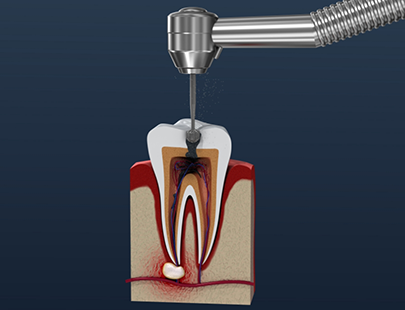Root Canal Treatment Flower Mound
Promptly Addressing the Source of Your Tooth Pain

At Fountain Park Dental, we understand the importance of saving natural teeth whenever possible. Root canal treatments in Flower Mound are essential procedures used to treat severely decayed or infected teeth that are often the source of immense dental pain. Dr. Chaudhari can use these treatments to relieve said pain and prevent the spread of infection, ultimately helping you avoid the need for tooth extraction. To learn more about this service or to schedule an emergency appointment, contact our office!
Why Choose Fountain Park Dental for Root Canal Treatment?
- Comfortable Dental Office with Patient-Friendly Amenities
- Skilled Dentist with 15+ Years of Experience
- Same-Day Emergency Treatment Available
The Benefits of a Root Canal
Pain Relief

One of the primary benefits of a root canal is immediate pain relief. Before the treatment, the tooth is often painful and sensitive due to infection or inflammation of the tooth pulp. A root canal removes this inflamed pulp, instantly easing pain and preventing further discomfort. Plus, we will numb your mouth immediately before the procedure to ensure that you feel absolutely no pain from there on out.
Prevention of Spread of Infection

A root canal helps prevent the spread of infection from the affected tooth to surrounding teeth or into the jawbone. This intervention is crucial as unchecked dental infections can lead to more serious health complications, including abscesses, bone loss in the jaw, and systemic infections affecting your overall health.
Tooth Preservation

Root canal treatment allows you to keep your natural tooth, avoiding the need for extraction and replacement. Plus, preserving your natural tooth helps maintain your jaw structure, prevents the shifting of surrounding teeth, and generally supports a more natural bite and smile aesthetics.
The Root Canal Treatment Process
Diagnosis and X-ray

The first step in the root canal process is a thorough diagnosis, which includes taking X-rays to determine the extent of tooth damage and the shape of the root canals. This information is critical to planning the effective treatment of the tooth; it also lets us keep you fully informed about the process.
Anesthesia and Pulp Removal

After the area is numbed with local anesthesia, an access hole is made into the tooth. Through this hole, the diseased tooth pulp is removed, and the inner chamber of the tooth is meticulously cleaned and sanitized.
Filling and Sealing

After the tooth has been cleaned, the space is filled with a biocompatible material called gutta-percha. Once the root canals have been filled, the tooth is sealed with a temporary filling. A follow-up visit is needed to place a permanent crown on the tooth to restore its full function and appearance.
